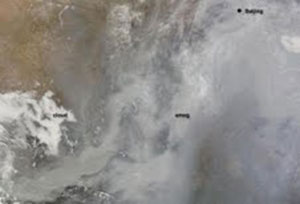Live in a large city like New York, London, Beijing or Mumbai, and you are likely exposed to more air pollution than people in smaller cities in surrounding areas. But exactly how a city’s pollution relates to the size of its population has never been measured, until now.
Using satellite observations, NASA scientists directly measured air pollution’s dependence on population in four of the planet’s major air pollution regions: the United States, Europe, China and India.
The study shows that the pollution-population relationship varies by region. For example, a city of 1 million people in Europe experiences six times higher nitrogen dioxide pollution than an equally populated city of 1 million people in India, according to the research led by Lok Lamsal, of NASA’s Goddard Space Flight Center in Greenbelt, Md. The variation is a reflection of regional differences such as industrial development, per capita emissions and geography. The study was published June 13 in Environmental Science & Technology.
Previously, researchers have measured the relationship between population and several urban characteristics, such as infrastructure, employment and innovation. “We show that the relationship is also applicable to pollution,” Lamsal said. “Measurement of that relationship is potentially useful for developing future inventories and formulating air pollution control policies.”
The researchers focused on nitrogen dioxide, or NO2, a common pollutant from the burning of fossil fuels. The gas is a precursor to the formation of near-ground ozone, which can cause respiratory problems and is a problem in many major metropolitan areas. NO2 is also unhealthy to breathe in high concentrations. One feature of the gas, however, is that it’s a good proxy for urban air quality.
Lok and colleagues studied data collected by the Ozone Monitoring Instrument on NASA’s Aura satellite, which measures NO2 throughout the atmosphere in the afternoon around the world. Next they used an air quality computer model to derive from the satellite data the annual mean concentration of the gas near the ground in some of the Northern Hemisphere’s major polluting regions, excluding hotspots such as power plants that could skew the urban relationship. By overlaying pollution concentration with population density data, the researchers could examine the relationship.
Results across the different regions showed divergent NO2 surface concentrations in urban areas of 1 million people: 0.98 parts per billion (U.S.), 1.33 ppb (Europe), 0.68 ppb (China) and 0.23 ppb (India). The same regions saw various degrees of pollution increases in cities with population of 10 million people: 2.55 ppb (U.S.), 3.86 ppb (Europe), 3.13 ppb (China) and 0.53 ppb (India).
The contribution to air pollution from surface-level NO2 in each region more than doubled when cities increased in population from 1 million to 10 million people, although in China the increase was much larger, by about a factor of five.
Even though larger cities are typically more energy efficient with lower per-capita emissions, more people still translates to more pollution. But the study reveals some noteworthy regional differences.
“Energy usage patterns and per capita emissions differ greatly between India and Europe,” Lamsal said. “Despite large populations, Indian cities seem cleaner in terms of NO2 pollution than the study’s other regions.”
The researchers say that further investigation is needed in order to clarify the causes behind the regional differences.
N.H.Khider
Source :Science daily

